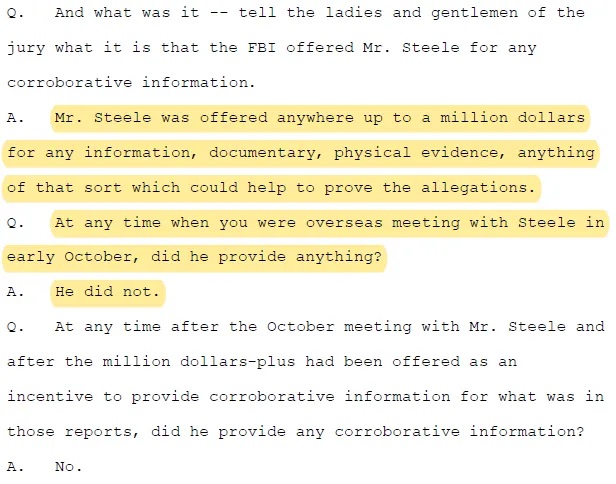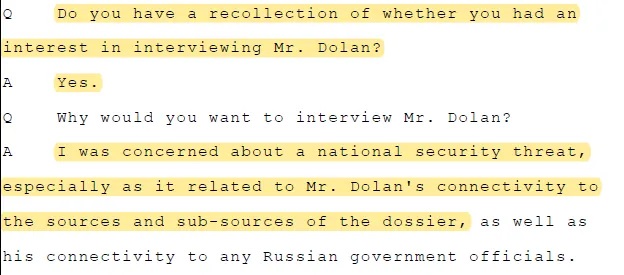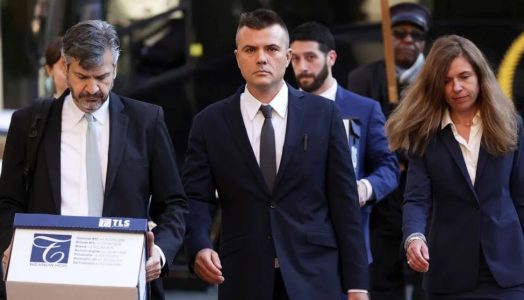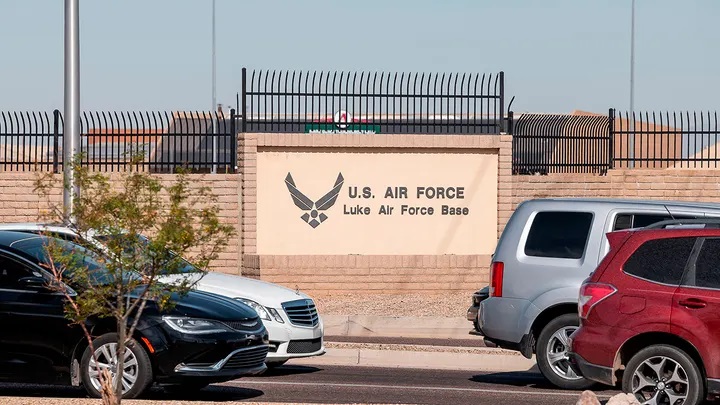Igor Danchenko was found not guilty of providing false statements to federal officials in the course of their “investigation” into the Steele Dossier. After count 1 was dismissed (the Charles Dolan count), these charges remained:
- Count 2. March 16, 2017: Danchenko told FBI agents he received a call in late July 2016 from a person he thought was Sergei Millian, when Danchenko knew he had never received a call from Millian.
- Count 3. May 18, 2017: Danchenko gave a false statement to FBI agents that he “was under the impression” that the late July 2016 call was from Millian.
- Count 4. October 24, 2017: Danchenko falsely stated to FBI agents that he believed he spoke to Millian on the phone on more than one occasion.
- Count 5. November 16, 2017: Danchenko lied that he “believed he has spoken to [Millian] on the telephone,” when Danchenko well knew he had never spoken to Millian.
That’s the difficulty of proving a false statements case when the FBI and the Mueller Special Counsel were uninterested in pursuing the truth.
As we’ve seen from the course of this trial, the most important takeaways from this trial have never been the alleged lies. Danchenko himself has long been known as a fabricator, with his deceptions revealed as soon as information on his involvement in the Steele Dossier, his background, and his FBI interviews was released. Cue observations from 2020 from ourselves and many others:
Did Steele’s primary sub-source lie to the FBI?
Sub-source told FBI “to his knowledge he has not had any contacts w/ the Russian intelligence.”
FBI files reveal repeated contacts & familiarity w/ Russian intelligence officials. 🤔
HT @FOOL_NELSON https://t.co/0NYuScxQed pic.twitter.com/eZ4SoV2YYZ
— Techno Fog (@Techno_Fog) September 24, 2020
What is more important is that which informs our understanding of the Trump/Russia investigation and the FBI/DOJ/Mueller misconduct that sparked Crossfire Hurricane and continued through the Mueller investigation. That information was revelatory. The institutions were on trial alongside Danchenko, with Durham recognizing in closing arguments that “the FBI mishandled the investigation at issue.” And the institutions rightly suffered. Danchenko might have been spared, but is there any reasonable doubt as to the FBI’s incompetence – and guilt?
TechnoFog provided some of the most comprehensive coverage of the Danchenko trial that you’ll find. Their goal is always provide the most relevant information, preferably through transcript excerpts where you, the reader, can see the testimony for yourself and reach your own conclusions. At the same time, they also aim for concision.
Here are some of the most important highlights from the trial:
- Steele was offered “up to a million dollars” to corroborate the Dossier.

- Danchenko was a confidential human source for the FBI from March 2017 through October 2020. He was accused of giving a number of false statements during that time period. He was paid over $200,000 as an informant, and his status as a CHS buried him as a witness. “Sources and methods.”
- The Mueller Special Counsel had FBI Agents and Analysts investigating the Steele Dossier – but purposefully limited the scope of that inquiry, making sure any information damning to their investigation would not be uncovered. Former FBI Intelligence Analyst Brittany Hertzog testified she learned of Charles Dolan’s connections to Danchenko during her time with the Mueller Special Counsel. She requested to interview Dolan; others opposed that request. The opposition won out.

- FBI Special Agent Amy Anderson, also part of the Mueller Special Counsel, requested to interview Dolan. Her request was shut down by superiors.

- Director Comey was informed on all parts of the Crossfire Hurricane investigation, from its beginnings up until (theoretically) his termination.
- FBI Special Agent Kevin Helson, who handed Danchenko as a confidential human source, omitted key derogatory information – that Danchenko was the target of a previous espionage case – in his opening paperwork.
- FBI Special Agent Kevin Helson was recommended to assess Danchenko’s employer and look at the financial nature of Danchenko’s employment. Helson failed to do so.
- FBI Special Agent Kevin Helson was recommended to investigate whether Danchenko lied in his visa and immigration documents. Helson failed to do so.
- FBI Special Agent Kevin Helson (there’s a purpose in the repetition) was recommended to conduct a polygraph of Danchenko to determine if he “has ever been tasked by a foreign individual, entity or government to collect information or to perform actions adverse to the U.S. interest.” Helson failed to polygraph Danchenko.
- Crossfire Hurricane started based on “a suggestion of some kind of suggestion” from a “friendly foreign government.” It was opened as a “full investigation,” which allowed for the use of “investigative tools” not allowed at the “preliminary investigation stage.
- The FBI wanted a FISA on Carter Page “fairly early on” – around the end of July 2016 or soon thereafter. However, the FBI didn’t have enough to “secure” the warrant. The evidence wasn’t there.
- FBI Analyst Brian Auten was unable to “confirm or corroborate” any of the Steele Dossier claims from the receipt of the document until the first FISA application in October 2016.
- FBI Analyst Brian Auten and FBI colleague Stephen Somma knew Democrat Charles Dolan could be a source of information of the Steele Dossier. Neither asked Danchenko about Dolan.
- Dolan would ultimately testify that he believed some Dossier information came from him.
- The FBI checked with other agencies and was unable to corroborate the Dossier info.
- FBI Analyst Brian Auten is a “subject” of the Durham investigation and will likely be “suspended” by the FBI.
- Sergei Millian was a confidential human source (CHS) for the FBI’s Atlanta Field Office. The Crossfire Hurricane team found no evidence Millian had “assisted in the interference” of the 2016 presidential election.
- While Danchenko told the FBI he spoke with Millian. E-mails from Millian demonstrate he had no idea who Millian was. The FBI/Mueller Special Counsel never obtained those e-mails.
The unanswered questions
When presented with the FBI failures documented during the Danchenko trial (and the Michael Sussmann trial), one can’t help but be reminded of their investigation of the DNC “hack.” Both investigations have similar types of “errors”: the failure to pursue investigative leads and collect evidence, and uncorroborated claims of Russian interference (or collusion) based on information provided by DNC/Clinton “contractors”.
Here, the FBI and Mueller Special Counsel refused to interview witnesses with knowledge of the Dossier allegations. In the case of the DNC “hack”, the FBI never obtained the DNC server. The FBI didn’t even obtain the unredacted Crowdstrike reports relating to the hack. Instead, the RBI relied upon Crowdstrike, hired on behalf of the DNC by disgraced attorney Michael Sussmann, to inform the FBI’s assessment of the hack. As Aaron Mate explained in this essential essay:
The fact that the Democratic Party employed the two private firms that generated the core allegations at the heart of Russiagate — Russian email hacking and Trump-Russia collusion – suggests that the federal investigation was compromised from the start.
At some point, “mistakes” consistently made in one direction cease to be harmless errors and become circumstantial evidence of something nefarious. (In another context we might call that the “cumulative weight of circumstantial evidence.”) While we can draw inferences from that behavior, Durham faces a more difficult task: using such circumstantial evidence to build a criminal case. Maybe he has more. Maybe not. Maybe these FBI agents and officials were adept at hiding their criminal conduct under the guise of incompetence or cluelessness or a poor memory.1
We also ask whether that’s it for Durham. The Wall Street Journal reported this would likely be the final prosecution of the Special Counsel, to be followed by a report detailing Durham’s findings. If that’s true, expect the report to be submitted after the midterms, absent further developments or other prosecutions by the Durham Special Counsel. If the reporting is true. We’ll see.
After the case was over, one email was identified in numerous documents that uncovered the entire corrupt plan to remove President Trump from office.
Jeff Carlson at the Epoch Times published an excellent story where he dissects what was found and its importance.
Below are some excerpts from Carlson’s work.
An FBI email previously not known to the public has revealed that the bureau planned to make Igor Danchenko—the primary source for British former spy Christopher Steele’s Trump dossier—a confidential human source (CHS) before it had even interviewed him.
The revelation, which was discovered as a result of special counsel John Durham’s case against Danchenko, indicates that the FBI deliberately targeted 2016 presidential candidate and later President Donald Trump with claims it already knew at the time to be false.
The email—of which only the subject line has been made public—was first uncovered by an internet sleuth who goes by the moniker “Walkafyre” and was included in hundreds of unused exhibits from Danchenko’s trial.
Holy moly, look what @walkafyre found. The FBI wanted to make Danchenko a CHS before they knew anything about him, before they interviewed him, before they knew his role in the dossier. It was always about hiding him from Russiagate inquiries. It was always about the cover up. pic.twitter.com/oTmNjjMdoS
— Hans Mahncke (@HansMahncke) October 19, 2022
Carlson then discusses the importance of this email which is totally redacted besides the header.
The newly discovered email was sent by FBI agent Kevin Helson to unknown recipients on Jan. 12, 2017. The email’s heading reads “Plan to Convert Danchenko into CHS.”
This email is critical for several reasons. It shows that the FBI intended to hide Steele’s main source behind CHS status after they had previously discovered Steele couldn’t back up the claims in his dossier despite their offer of $1 million to him for any corroboration. As a CHS, Danchenko also would be shielded from any external investigations—including those of Congress.
Of equal importance, Helson’s email also proves that the FBI planned to convert Danchenko into a CHS before the FBI had even interviewed Danchenko. Had they thought the dossier was real, there would have been no reason to hide Danchenko. Instead, the FBI would’ve been touting the existence of a crucial source…
…This move by the FBI also directly coincided with President Barack Obama’s wishes expressed during a Jan. 5 White House intelligence briefing on the dossier that he wanted to withhold information from the incoming Trump administration.
Things really took off after candidate Trump won the election.
The unexpected election of Trump on Nov. 8, 2016, prompted an unprecedented response from the intelligence community and Washington establishment. The effort to undermine Trump and his administration began almost immediately after his victory.
On Nov. 9, 2016, FBI agent Peter Strzok and FBI lawyer Lisa Page exchanged texts that referred to a “secret society” the day after Trump’s victory. Page texted Strzok saying, “Maybe this should be the first meeting of the Secret Society.”
Strzok responded to Page saying, “Too hard to explain here. Election related.” The next day, Strzok texted Page saying, “Bill [Priestap, head of FBI Counterintelligence] just sent a two hour invite to talk strategy.”
The famous meeting on January 5th with Obama and his Deep State in the White House came next:
On Jan. 10, 2017, following his Jan. 5 briefing to Obama and his abbreviated briefing to Trump on Jan. 6, Comey testified before the Senate Intelligence Committee. During the hearing, Comey was asked by Sen. Ron Wyden (D-Ore.) if the FBI was investigating relationships between associates of Trump and the Russian government. Comey stated that he could neither confirm nor deny an active investigation, thereby setting the media frenzy of Trump–Russia collusion into motion. The Steele dossier would be released by BuzzFeed on the same day.
The day after Comey’s testimony, the Senate Intelligence Committee opened an investigation into Russian interference and the Trump campaign. Its report proved to be politically driven and much of it has been discredited.
On Jan. 12, 2017, the same day that Helson sent his email regarding Danchenko, and just a day after Trump’s surprise press conference, DOJ Inspector General Michael Horowitz announced his initiation of a review of actions taken by the FBI in the leadup to the 2016 presidential election.
It isn’t known whether Horowitz was ever briefed about Danchenko’s CHS status or the million-dollar bounty. His report mentions neither. By design or by accident, Horowitz’s investigation effectively tied up any outside probes into the FBI’s actions for two years.
It was on the same day, Jan. 12, that Flynn’s Dec. 29, 2016, call with Russian ambassador Sergey Kislyak was leaked to David Ignatius at The Washington Post. The leaker was never found, possibly because the leak came from within the FBI itself. Ignatius’s article, which further pushed the Trump–Russia collusion narrative, portrayed Flynn as undermining Obama’s fresh Russian sanctions during his call with Kislyak.
The article also raised the possibility that Flynn had violated the Logan Act, an obscure, 200-year-old law. Interestingly, it was Vice President Joe Biden who first suggested using the Logan Act against Flynn at the Jan. 5 White House meeting with Comey.Flynn, who is believed to have been the person who asked Comey probing questions about the dossier’s sources, appears to have been the Intelligence Community’s first target in its effort to oust Trump. On Jan. 19, 2017, the day before Trump’s inauguration, Obama’s top intelligence and law-enforcement deputies met to talk about Flynn’s conversation with Kislyak. Flynn would be sworn in as Trump’s national security adviser on Jan. 22, 2017, and was subjected to an ambush interview by Strzok at the behest of Comey two days later.
Comey later bragged about the Flynn ambush having been his brainchild.
Carlson lists many activities that then sprouted from the fake dossier which was used for the entire effort to remove President Trump from office. All of those, of which there were many, that knew the Steele dossier was a lie were lying for years by not bringing this to the surface. Carlson concludes with this.
While it’s been claimed by some media outlets that the dossier wasn’t central to the allegations against Trump, the Intelligence Community’s efforts to ensnare Trump, the Carter Page FISA application, as well as the March 6 and 8 briefing notes, all rely almost entirely on the dossier. Additionally, we know that Comey insisted that a summary of the dossier be attached to the ICA that was presented to Obama. These actions prove beyond any doubt that the case against Trump was based on a fabricated document…
…Significantly, the many efforts to ensnare Trump, from the framing of Flynn to the media’s relentless airing of dossier smears and the Washington establishment’s push for a special counsel, couldn’t have happened unless Danchenko was kept hidden by the FBI. It was perhaps the most critical part of the effort and, as we have now learned, it happened much earlier than had been known.
Although the result of the Danchenko trial was disappointing it was not the end of the Crossfire hurricane scandal. According to Paul Sperry, the FBI conspiracy to defraud the American public can be prosecuted no later than 7 years after the offense is committed. Dirty Andrew McCabe signed the last fraudulent FISA request to spy on the Trump administration in 2017. The warrant expired on September 22, 2017. Therefore, Durham had until September 2024 to file fraud charges against Andrew McCabe. Durham is reportedly filing a report instead.2
Notes
- This reminds us of Horowitz’s report on the Carter Page FISAs, which made such findings such as: “While we found no documentary or testimonial evidence that this pattern of errors by Case Agent 1 was intentional, we also did not find his explanations for so many significant and repeated failures to be satisfactory.”
Sources:




